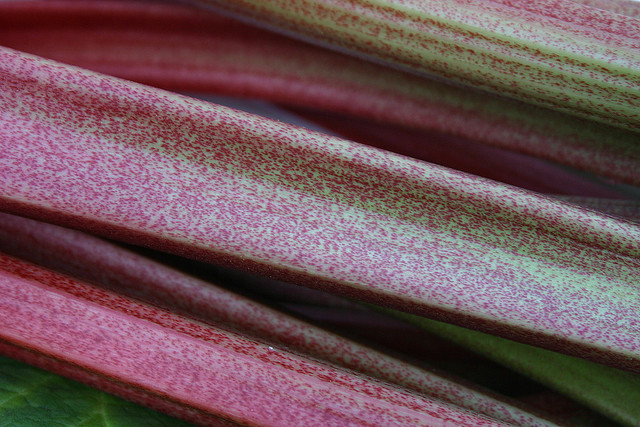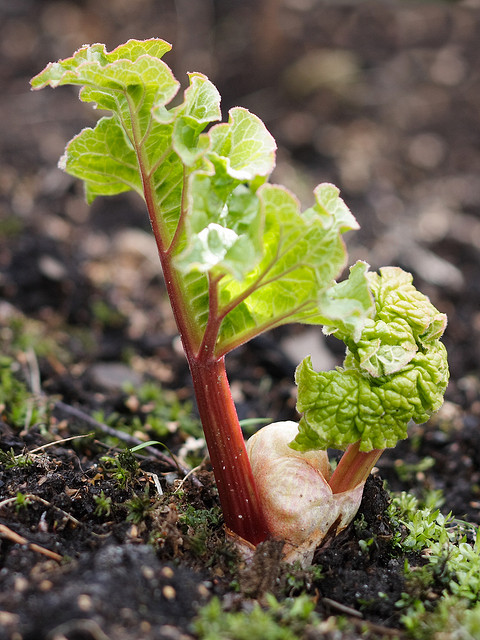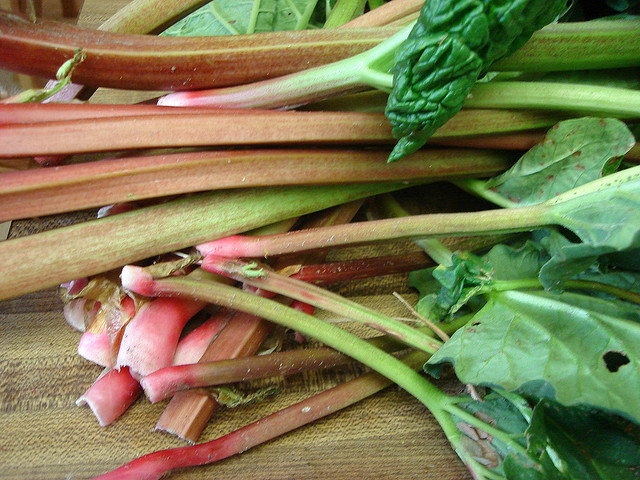The reliable rhubarb. Posted by hulda on Sep 30, 2014 in Icelandic culture, Icelandic customs, Icelandic history
Last week’s Recipe for Marital Bliss reminded me again of something very Icelandic – rabarbari or tröllasúra (= trolls’ sour), rhubarb. While it does not originate in Iceland and in fact arrived here comparatively late (from Denmark and at the end of the 1800’s) Icelanders really took a liking to it. And why not – it’s one of the rare few garden plants that actually thrives in Icelandic climate with ease, requires almost no attention at all and yields several crops per summer; rhubarb became quite a multipurpose plant over here. Besides the obvious uses in bakery products, jellies and syrups, rhubarb has also been used as a dye and a mild poison for fighting insects.
Its quickly spread popularity did not mean it was a highly valued food item though, quite the opposite. It reminds me of the popularity of apples in Finland: though nearly every house has an apple tree and they’re a steady part of the cuisine they’re not actually considered special at all, simply because they’re everywhere!
Icelanders of old preferred meat to vegetables any day, and rhubarb was something people ate because, well, meat was expensive, few plants could grow here but you still have to eat something at least. This occasionally lead to sad misunderstandings because people who got more vitamins from their food tended to be healthier than those who didn’t, and one of our professors told us a story of a woman being accused of stealing sheep based on this. She was a widow and much too poor to actually buy meat, or own sheep of her own, yet her children were considered “suspiciously beautiful”. This coupled with a sheep or two going missing lead people to suspect her of theft… but what did she have to say as her defense?
She had not fed them meat at all, only basic food and a lot of rhubarb.
Our professor didn’t know how the story ended, alas, but fact is that sometimes sheep can die during the summer and because they roam free during that time it can go unnoticed for a while. Another fact is that rhubarb really did grow everywhere. Icelanders grow many types of rhubarb – the botanical garden alone has 16 types to display – and on occasion they can even be found growing wild.
Nowadays rhubarb is mostly a sweet treat rather than a staple of diet. It plays an important role in many cakes and pies such as randalín (here) and the last week’s hjónabandssæla, and though many recipes give another option for filling rhubarb is still the “right” one, the flavour that the whole cake or pie is designed for. Prune jam randalín tastes slightly too sweet and hjónabandssæla with strawberry jam instead of rhubarb is too sour. Icelandic rhubarb is quite sweet, especially when the stalks are small, so sweet in fact that children eat them raw, dipped in sugar (link). There’s even types of candy that imitate rhubarb in both taste and looks.
Let’s not forget the other uses either while we honour this sturdy, generous and reliable plant. The leaves are poisonous but you don’t have to throw them away – you can use them to f.ex. dye natural fibres! You only need to cut them small, put into a pot of water, bring to boil and let simmer under a lid for an hour. Let cool and remove the leaves. Wet your fabric, place into dye and heat slowly, simmer under a lid for 30-50 min. Remove from dye bath and rinse well. The resulting colour is a shade of golden yellow to green, depending on the acidity of the mixture. You don’t need to fix the dye either since the acid in rhubarb itself does that already.
Or you can use it as a pesticide. For that you need 10-12 leaves of rhubarb, 4 tbsp organic soap and 5 litres of water. Put water and rhubarb into a pot, bring to boil and simmer under a lid for 3h. Remove leaves, add the soap while its still hot and mix well. Let cool and sprinkle on plants you want to protect against insects. This pesticide has even been used on trees, but you may need to sprinkle them twice.
Did you know that actually the name “tröllasúra” is, at least technically speaking, more correct than “rabarbara” because the latter is a loan word? Yet no one really uses tröllasúra when they speak of rhubarb. There are a few more loan words like that in daily use that have a real Icelandic version as well – the video introduces some of them.
PS For those of you who have already studied Icelandic for some time I recommend Aðalheiður Marta Steindórsdóttir’s thesis called Tröllasúran trygga; rabarbari í íslenskri matargerð, the reliable rhubarb; rhubarb in Icelandic cuisine (link).

Build vocabulary, practice pronunciation, and more with Transparent Language Online. Available anytime, anywhere, on any device.
About the Author: hulda
Hi, I'm Hulda, originally Finnish but now living in the suburbs of Reykjavík. I'm here to help you in any way I can if you're considering learning Icelandic. Nice to meet you!






